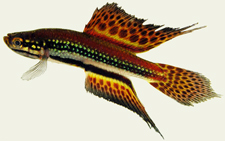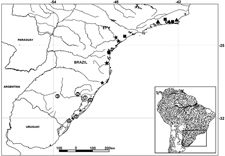History
southern Brazil. The relationships of the new species among taxa of the subtribe Cynopoecilina is discussed based on two analyses: one using 71 discrete characters and other with the addition of six continuous characters analyzed without discretization. The addition of the continuous characters resulted in the first fully resolved phylogenies for Cynopoecilus and Leptolebias species, not obtained in the analysis including only discrete characters. The new species is assigned to Cynopoecilus as sister group to the remaining species of the genus. A new diagnosis is proposed for Cynopoecilus to accommodate the new species. The resulting phylogeny indicates that the occupation of the grasslands of the Pampa biome by the species of Cynopoecilus occurred along the evolution of the genus and that this event was significant for the diversification of the genus.
Reproduction
Cynopoecilus is living more in the south of the continent in Uruguay and south Brasil and can stand also low temperatures, even below 12 C for a while and can stand also hot values as 28 C. They are not real divers and females drop there eggs also above the bottomlayer in many occasions. The fertilisation is probably internal as males can generate a sort of gonopodium, an tubelike constellation of the first rays of the anal fin.
It is advised to keep one male with more than one female because males can drive females to hard in smaller breedingtanks without much of shelter. In nature they live in soft and acid waters, not far from large waterbodies in stagnant shallow pools that occasionally, but not always, dry out.
Breeding this species is not to difficult if kept in the proper waterquality and fed mainly by live food like mosquito lavae and white worms. Eggs should have an incubation lag of 3 to 4 months and watered with cool water after being stored in damp peat.
After the first group of juveniles has hatched and removed into an other tank, repack the peat for another 4 weeks and water them again after that period. Often a large number of eggs do develop more slow for savety reasons. Growth is fast if life food is given daily. Maturity in 6 weeks. The assumed lifespan is 1,5 year, under cooler conditions possible longer.
Variations
Map
Meristics
Dorsal 0.0,
Anal 00.0,
D/A 00.0
LL scale count (average) 00.0
Pre- dorsal length to % SL – 00.0 %
Depth to % SL – 00.0 %
Literature
Ferrer J, J. M. Wingert and L. R. Malabarba, 2014. Description of a new species and phylogenetic analysis of the subtribe Cynopoecilina, including continuous characters without discretization (Cyprinodontiformes: Rivulidae). Zoological Journal of the Linnean Society, 2014, 172, 846–866. fig. 9

